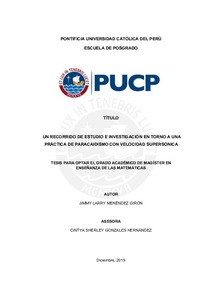| dc.contributor.advisor | Gonzales Hernández, Cintya Sherley | |
| dc.contributor.author | Menéndez Girón, Jimmy Larry | |
| dc.date.accessioned | 2020-05-05T20:26:52Z | |
| dc.date.available | 2020-05-05T20:26:52Z | |
| dc.date.created | 2019 | |
| dc.date.issued | 2020-05-05 | |
| dc.identifier.uri | http://hdl.handle.net/20.500.12404/16175 | |
| dc.description.abstract | El modelo educativo actual promueve un plan de enseñanza y aprendizaje basado en la resolución de problemas. Sin embargo, en este paradigma tradicional se presentan situaciones contextuales donde no se promueve la indagación tampoco un aprendizaje basado en preguntas, solo se presentan respuestas a cuestiones que los estudiantes no se formulan, quedando desplazados completamente por el aprendizaje receptivo en el que el profesor es el transmisor de conocimientos, con una enseñanza en la que no se presenta la razón del estudio de las matemáticas. Considerando el marco teórico y metodológico de la Teoría Antropológica de lo didáctico, concretamente su método de análisis clínico didáctico, nos proponemos como objetivo analizar la implementación de una actividad didáctica, que generará un Recorrido de Estudio e Investigación (REI), que permite concretar en aula el paradigma del cuestionamiento del mundo, que por su naturaleza diversa al paradigma tradicional, se presenta como un método alternativo para fomentar un aprendizaje y una enseñanza basada en la indagación. La cuestión generatriz que materializa el objetivo de investigación y con la que se da apertura al recorrido de estudio nace de un análisis de las prácticas de paracaidismo y específicamente de un salto de paracaidismo estratosférico, que parte con la cuestión: ¿Cómo habrá sido posible determinar desde qué altura es necesario lanzarse para alcanzar la velocidad del sonido? ¿Cómo varía la velocidad durante el descenso hasta cuando se abre el paracaídas? Con base a esta investigación se observó que en el REI la cuestión generatriz evolucionó a través de diferentes cuestiones derivadas que implicaron el uso de obras de distintas ramas de conocimiento, entre ellos la noción de derivada a partir de la articulación de la noción de tasa de variación media, la noción velocidad promedio y la noción del movimiento rectilíneo uniforme, uniformemente variado, configurando de este modo un REI de tipo bidisciplinar, que se apoya en la Física, en la Matemática así como también en el contexto del paracaidismo. | es_ES |
| dc.description.abstract | The current educational model promotes a teaching and learning plan based on problem solving. However, in this traditional paradigm, contextual situations are presented where inquiry is not promoted, nor is question-based learning, only answers to questions that students do not formulate, being completely displaced by receptive learning in which the teacher is the transmitter of knowledge, with a teaching in which the reason for the study of mathematics is not presented.
Considering the theoretical and methodological framework of the Anthropological Theory of the didactic, specifically its method of didactic clinical analysis, we aim to analize the implementation of a didactic activity, which will generate a Study and Research Path (SRP) that allows to implement in the classroom the paradigm of the questioning of the world, which due to its nature different from the traditional paradigm, is presented as an alternative method to promote learning and teaching based on inquiry. The generating question that materializes the research objective and with which the study path opens is born from an analysis of skydiving practices and specifically from a stratospheric skydiving jump, which starts with the question: How could it have been possible to determine from what height is it necessary to launch to reach the speed of sound? How does the speed vary during the descent until the parachute opens? Based on this research, it was observed that in the SRP the generating question evolved through different derived questions that allowed the use of works from different branches of knowledge including the notion of derivative to emerge from the articulation of the notion of average variation rate, the notion of average velocity and the notion of uniform rectilinear movement, uniformly varied, thus configuring a SRP of a two-disciplinary type, which is based on Physics, Mathematics and in the context of skydiving. | es_ES |
| dc.language.iso | spa | es_ES |
| dc.publisher | Pontificia Universidad Católica del Perú | es_ES |
| dc.rights | info:eu-repo/semantics/openAccess | es_ES |
| dc.rights.uri | http://creativecommons.org/licenses/by/2.5/pe/ | * |
| dc.subject | Matemáticas--Estudio y enseñanza | es_ES |
| dc.subject | Cálculo--Estudio y enseñanza | es_ES |
| dc.subject | Aprendizaje (Educación)--Metodología | es_ES |
| dc.title | Un recorrido de estudio e investigación en torno a una práctica de paracaidismo con velocidad supersónica | es_ES |
| dc.type | info:eu-repo/semantics/masterThesis | es_ES |
| thesis.degree.name | Maestro en la enseñanza de las Matemáticas | es_ES |
| thesis.degree.level | Maestría | es_ES |
| thesis.degree.grantor | Pontificia Universidad Católica del Perú. Escuela de Posgrado | es_ES |
| thesis.degree.discipline | Enseñanza de las Matemáticas | es_ES |
| renati.advisor.orcid | https://orcid.org/0000-0003-2130-1710 | es_ES |
| renati.discipline | 199117 | es_ES |
| renati.level | https://purl.org/pe-repo/renati/level#maestro | es_ES |
| renati.type | http://purl.org/pe-repo/renati/type#tesis | es_ES |
| dc.publisher.country | PE | es_ES |
| dc.subject.ocde | https://purl.org/pe-repo/ocde/ford#5.03.01 | es_ES |






